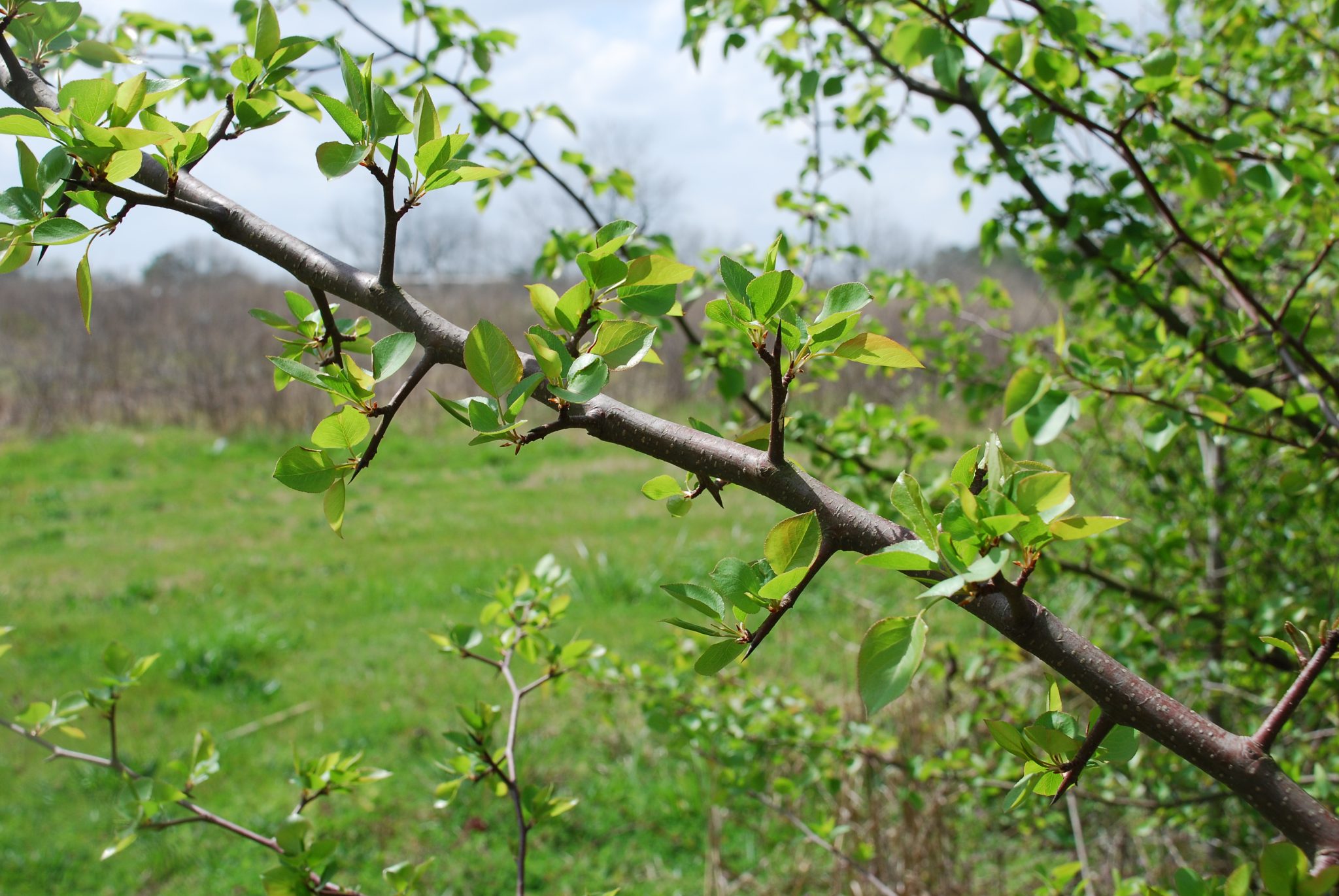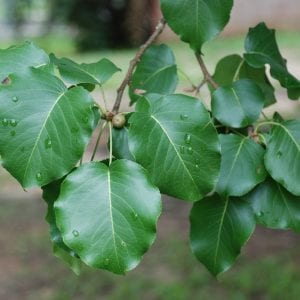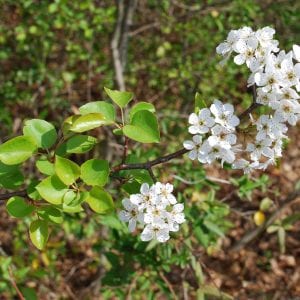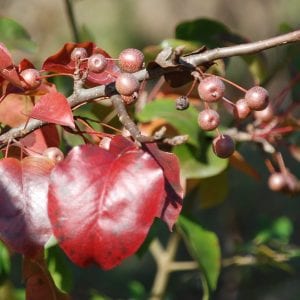Forestry & Wildlife

Popularly known by the cultivar name ‘Bradford’ pear, Callery pear has become an invasive species in natural and disturbed environments.
The introduction of Callery pear (Pyrus calleryana) serves as a cautionary tale of how good intentions can sometimes go wrong. This native of southeastern Asia was imported to the United States in the early 20th century for use in breeding programs to increase fire blight resistance in common pears. Before long it became clear that the Callery pear also had incredible potential as a horticultural tree.
With its high degree of tolerance to environmental stresses, rapid growth, and early abundant flowering, Callery pear became a very popular street and landscaping tree. While many cultivated varieties (cultivars) were developed over the years, the ‘Bradford’ is the best known. In fact, many people call the species by the name Bradford pear.
For many years, Callery pear served its purpose as a useful horticultural species. Problems began to appear, however, that had not been fully expected—problems that today’s homeowners and professionals must be aware of and know how to address.
Callery Pear Invasion
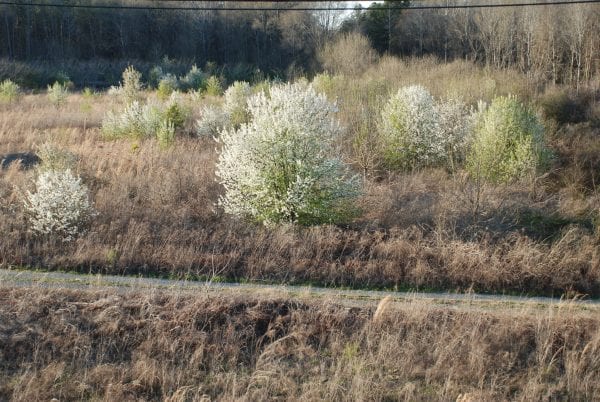
Figure 1. Callery pear colonizing an open field. Flowering can begin in trees as young as 3 years old.
Callery pears are rapidly growing trees that can form dense thickets, outcompeting native plants for light, water, and nutrients. The species has proven very successful at invading disturbed areas, open fields (figure 1), unimproved pastures, rights of ways, and forest edges. It is tolerant of partial shade and sites with dry to wet soils. As they continue to spread, it is likely that a greater array of sites will be prone to invasion, including managed pine stands.
The reason for this invasive spread lies with the way the species breeds and the fruit it produces as a result. Callery pear is self-incompatible, which means it requires outcrossing with genetically different plants for successful fruit production. Because all trees within an individual cultivar are genetically the same, they are unable to cross-pollinate.
For years, ‘Bradford’ was the most planted cultivar, and very little fruit was produced because they could not cross-pollinate. Over time, the Bradford cultivar was found to be structurally weak due to its branching pattern and was replaced with other cultivars. This shift greatly increased the genetic diversity of ornamental plantings and led to opportunities for outcrossing and successful fruiting. In many urban areas, Callery pear trees are now loaded with fruit in the fall where none were previously produced.
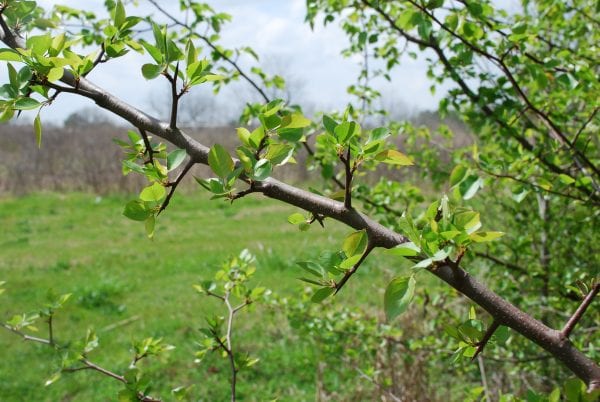
Figure 2. Sharp spur shoots (thorns) add to the problems associated with Callery pear invasions (photo by Nancy Loewenstein)
Callery pear fruit are eaten by birds and other animals, which spread the seed far and wide. As is seen in apples and other pears, the seed produced by Callery pear cultivars are not true to the parents and often appear more like the wild types from the native range. Furthermore, naturalized plants are often able to cross- pollinate and produce viable seeds. Most are very thorny with sharp spur shoots (figure 2) that persist even on older trees. The thorny spur shoots are sharp enough to puncture tires, which is especially problematic when the trees invade pastures that are mowed or bush hogged. The thorns also make control more challenging to applicators working through infestations.
Pollinators visit Callery pear flowers, but few insects utilize the leaves. This is significant because many bird species depend on leaf-feeding caterpillars and other insects to feed their young. Some birds eat the fruit, but they spread the seeds, which adds to the problem.
Identification of Callery Pear
Open grown Callery pear trees reach a height of 30 to 60 feet and are easily recognized by their teardrop shape, showy white flowers in the early spring, and brightly colored leaves in the fall. Naturalized trees are easily overlooked when not in bloom and can be a bit more challenging to identify. Following are distinguishing characteristics:
- Leaves (figure 3): Alternate, often tufted on short branchlets; oval to somewhat heart-shaped with a tapered tip, 11⁄2 to 31⁄2 inches long; finely crenate (round-toothed) margins; dark green above, light green below, developing a leathery texture with age. Fall color ranges from brilliant reds and maroons to oranges and yellows. Petioles (leaf stems) range from 1 to 2 inches long.
- Flowers (figure 4): Bloom February to April, appearing with or before the leaves; clusters of white, five- petaled flowers, 1 inch across with many maroon- tipped anthers; unpleasant scent
- Fruit (figure 5): June to February; persistent clusters of small pears, 3/10 to 5/10 inches across; green becoming tan or reddish when ripe, covered in speckles, on long stems; contain two to six maroon seeds
- Figure 3. Callery pear leaves
- Figure 4. Flowers appear with or before the leaves
- Figure 5. Callery pear fruit and fall color
Control in Residential Areas
Consider removing planted cultivars of Callery pear from your landscape. Several native alternatives can provide similar flowers or fall color as well as much better habitat for birds and other wildlife.
- Native alternatives with similar flowers: serviceberry (Amelanchier spp.), hawthorn (Crataegus spp.), native crabapple (Malus coronaria), native plum (Prunus spp.)
- Native alternatives with fall color: Florida maple (Acer floridanum), chalk maple (A. leucoderme), blackgum (Nyssa sylvatica)
For large trees within landscapes, removal followed by stump grinding is recommended. It is important to remove lateral roots; otherwise they will continue to sprout. If stump grinding is not an option, cut stump herbicide treatment is essential (table 1).
Table 1. Recommended Herbicide Rates for Residential Landscaping Use
bCut stump treatment involves cutting the plant down at the base and quickly treating the cut surface with the herbicide, which if not used full strength should be mixed with water.
cPathfinder II is a “ready to use” formulation requiring no mixing or dilution.
| Herbicide Active Ingredient | Herbicide Trade Name | Application Method | Rate |
|---|---|---|---|
| Glyphosate | Roundup or generics (41% active ingredient or higher) | Foliar spraya | 2% v/v (2.5 fl oz/gal) |
| Glyphosate | Roundup or generics (41% active ingredient or higher) | Cut stumpb | 50–100% v/v |
| Glyphosate + triclopyr | Roundup Poison Ivy Plus Brush Killer | Foliar spray | 6 fl oz/gal |
| Triclopyr amine | BioAdvanced Brush Killer Plus (8.8% tricloyr) | Foliar IPT | 4 fl oz/gal |
| Triclopyr amine | BioAdvanced Brush Killer Plus (8.8% tricloyr) | Cut stump | 100% |
| Triclopyr ester | Pathfinder II | Basal barkc | 100% |
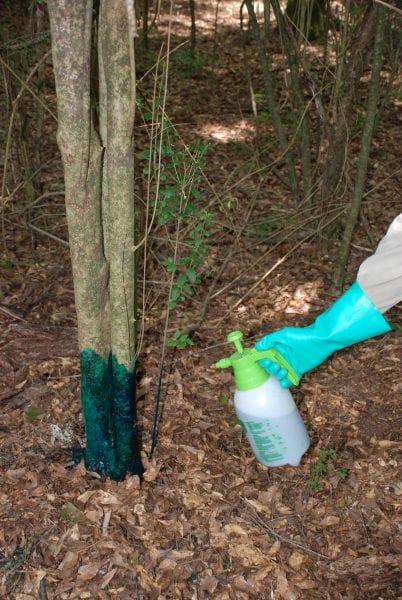
Figure 6. Including an indicator dye can help keep track of basal bark treatments.
When dealing with new Callery pear volunteers in your landscape, you can pull scattered seedlings and small saplings when the soil is moist, but be careful with the thorns. Another option for controlling small plants is a foliar herbicide treatment using a triclopyr or glyphosate product in mid-to-late summer (table 1). Several “ready to use” formulations of glyphosate and/or triclopyr amine labeled for brush control may be used (available in box stores). Be sure to get coverage of the entire plant but not to the point where herbicide is dripping off the leaves. Also beware of drift to avoid damage to nearby plants. With any of these herbicide treatments you can expect some regrowth, in which case retreatment will be necessary.
Another approach you can use for stems less than 6 inches in diameter is a basal bark treatment (figure 6) in which a triclopyr ester product (Pathfinder II) is sprayed over the lower 12 to 15 inches of each trunk. Be sure to get good coverage of the entire stem but avoid the thorns and avoid puddling herbicide on the soil. Because this product has some soil activity and nearby plants may be harmed, do not use this approach near any desirable vegetation. Also, do not use basal bark treatment in areas where standing dead trees will present a hazard. When using herbicides always read and follow the label.
Non-residential Control
Callery pear can be difficult to control, and research on the most effective treatments is lacking. However, treatments similar to those used for Chinese privet, Chinese tallowtree, and other woody invasives are outlined in table 2. If spraying plants near water, use an herbicide that is labeled for use in or near water.
Table 2. Recommended Herbicide Rates and Uses for Non-residential Sites
bThe addition of a non-ionic surfactant at 0.25% v/v is recommended for foliar herbicide treatments unless a surfactant is included in the formulation.
cIPT (individual plant treatment) is the term used to distinguish herbicide rate recommendations on a percentage basis rather than on a per-acre basis, which is used for broadcast treatments.
d DBH (diameter at breast height)
eHerbicide is mixed with a penetrating oil carrier rather than water to allow the herbicide to penetrate through the bark. Diesel fuel can be used, but newer oil carriers such as basal and bark oils are safer and just as effective. Where trees can be left standing, thorns should soften enough by the time they fall over that they will no longer be a danger for tire puncture.
fRead and follow label instructions as site-specific rates may vary.
| Herbicide Active Ingredient | Herbicide Trade Name | Application Method | Rate | Sitef |
|---|---|---|---|---|
| Aminocyclopyrachlora | Method | Basal bark (before bud break) | 10–20% solution + penetrating oil | Non-crop sites (ROWs, fence rows, industrial areas, substations, etc.) |
| Aminocyclopyrachlora | Method | Broadcast foliarb (May–August) | 10–18 fl oz/A | Non-crop sites (ROWs, fence rows, industrial areas, substations, etc.) |
| Aminocyclopyrachlora | Method | Frill or cut stump (April–October) | 0.5–1 ml/incision or 5–10% v/v solution | Non-crop sites (ROWs, fence rows, industrial areas, substations, etc.) |
| Glyphosate | Roundup or generics (41% active ingredient or higher) | Foliar IPTc | 2–10% v/v in 1 to 100 gal | Industrial sites, forestry, range and pasture, ROWs |
| Glyphosate | Roundup or generics (41% active ingredient or higher) | Frill or girdle | 1 ml/2 ̋ of trunk diameter | Industrial sites, forestry, range and pasture, ROWs |
| Glyphosate | Roundup or generics (41% active ingredient or higher) | Cut stump | 50–100% v/v solution | Industrial sites, forestry, range and pasture, ROWs |
| Imazapyra | Arsenal (2 lb ae), Habitat, or generics | Broadcast | 3–6 pts/A | Non-crop, range and pasture, aquatic, forestry, natural areas |
| Imazapyra | Arsenal (2 lb ae), Habitat, or generics | Foliar IPT | 0.5% v/v | Non-crop, range and pasture, aquatic, forestry, natural areas |
| Imazapyra | Arsenal (2 lb ae), Habitat, or generics | Cut stump | 6–9% v/v | Non-crop, range and pasture, aquatic, forestry, natural areas |
| Triclopyr amine | Garlon 3A, Renovate, or generics | Foliar IPT | 0.5–2% v/v solution | Forests, non-crop areas, natural areas, range, and pasture |
| Triclopyr amine | Garlon 3A, Renovate, or generics | Broadcast | Up to 2/3 gal/A in grazed sites and up to 3 gal/A in non-grazed sites | Forests, non-crop areas, natural areas, range, and pasture |
| Triclopyr amine | Garlon 3A, Renovate, or generics | Hack and squirt or frill | 0.5 ml/incision every 2"at DBHd | Forests, non-crop areas, natural areas, range, and pasture |
| Triclopyr amine | Garlon 3A, Renovate, or generics | Cut stump | Spray or paint with undiluted solution | Forests, non-crop areas, natural areas, range, and pasture |
| Triclopyr ester | Garlon 4 Ultra, Remedy Ultra, Pathfinder II, or generics | Foliar IPT | Up to 5% v/v in 10–100 gallons spray | Forests, non-crop areas, natural areas, range and pasture |
| Triclopyr ester | Garlon 4 Ultra, Remedy Ultra, Pathfinder II, or generics | Basal bark | 20–30% v/v solution + penetrating oile | Forests, non-crop areas, natural areas, range and pasture |
| Triclopyr ester | Garlon 4 Ultra, Remedy Ultra, Pathfinder II, or generics | Cut stump | 20–30% v/v solution + penetrating oil | Forests, non-crop areas, natural areas, range and pasture |
Additional Resources
Basal Bark Herbicide Treatment for Invasive Plants in Pastures, Natural Areas, and Forests, Extension publication ANR-1466, www.aces.edu/blog/topics/ control-invasive-plants/basal-bark-herbicide- treatment-for-invasive-plants-in-pastures-natural- areas-and-forests/
Cut Stump Herbicide Treatments for Invasive Plant Control, Extension publication ANR-1465, www. aces.edu/blog/topics/forestry-wildlife/cut-stump- herbicide-treatments-for-invasive-plant-control/
 Nancy Loewenstein, Extension Specialist; Forestry, Wildlife & Natural Resources; David Russell, Assistant Research & Extension Professor, Auburn University; and Stephen Enloe, University of Florida
Nancy Loewenstein, Extension Specialist; Forestry, Wildlife & Natural Resources; David Russell, Assistant Research & Extension Professor, Auburn University; and Stephen Enloe, University of Florida
New July 2020, Callery Pear: History, Identification, and Control, FOR-2078

